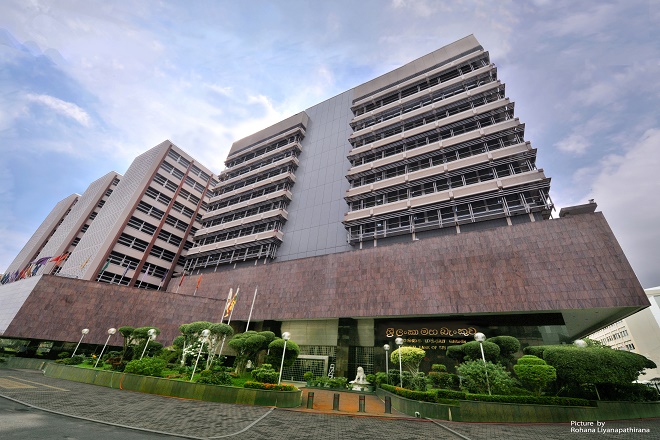Sri Lanka’s Central Bank keeps policy rates steady

June 24, 2016 (LBO) – Sri Lanka’s Central Bank has decided to keep its key interest rates steady for a fourth straight month on Friday, despite rising inflation and high private sector credit growth.
The full text of the statement is reproduced below.
Monetary Policy Review – June 2016
According to provisional estimates of the Department of Census and Statistics (DCS), the Sri Lankan economy grew by 5.5 per cent, in real terms, in the first quarter of 2016 compared to the growth of 2.5 per cent recorded in the last quarter of 2015. Economic growth was mainly supported by the expansion of Industry and Services related activities, which grew by 8.3 per cent and 4.9 per cent, respectively, during the first quarter of 2016 in value added terms. Meanwhile, Agriculture related activities recorded a moderate growth of 1.9 per cent during this period. The growth rate recorded in the first quarter was broadly in line with expectations for the year.
As anticipated, inflation increased in the month of May reflecting the impact of the increase in Value Added Tax (VAT) and the removal of certain exemptions applicable on VAT and Nation Building Tax (NBT), as well as the supply side disruptions due to adverse weather conditions. Accordingly, the Colombo Consumers’ Price Index (CCPI, 2006/2007=100) based headline inflation increased to 4.8 per cent, year-on-year, in May 2016 from 3.1 per cent in the previous month, while the National Consumer Price Index (NCPI, 2013=100) based headline inflation also increased to 5.3 per cent, year-on-year, in May 2016 from 4.3 per cent in the previous month. Core inflation as measured by both CCPI and NCPI also increased in May 2016 mainly reflecting the impact of revisions made to the tax structure by the government. In spite of these transitory price movements, inflation is expected to moderate in the period ahead and remain in mid-single digits in the medium term supported by appropriate demand management policies.
In the monetary sector, the year-on-year growth of broad money (M2b) decelerated to 18.2 per cent in April 2016 compared to 18.9 per cent recorded in March 2016. The expansion in credit to the private sector and the government remained key drivers of broad money growth, while credit to public corporations recorded a repayment during the first four months of the year. Credit extended to the private sector by commercial banks grew by 28.1 per cent in April 2016 on a year-on-year basis, although in absolute terms, disbursements in April 2016 were limited to Rs. 27.4 billion compared to Rs. 87.7 billion in the previous month. Short term money market rates displayed some stabilisation, while the upward trend observed in other retail market interest rates continued reflecting the gradual transmission of the monetary policy measures that were taken previously, amidst low levels of rupee liquidity in the domestic money market.
On the external front of the economy, the deficit in the trade account contracted by 2.4 per cent during the first four months of 2016, on a year-on-year basis, as the decline in imports was greater than the contraction in exports. Earnings from tourism were estimated to have increased by around 18.4 per cent during the period from January to May 2016, while workers’ remittances increased by 4.7 per cent during the period from January to April 2016. Gross official reserves were estimated at US dollars 5.6 billion by end May 2016.
Meanwhile, the Executive Board of the International Monetary Fund (IMF) approved a three year Extended Fund Facility (EFF) of SDR 1.1 billion (approximately US dollars 1.5 billion) for Sri Lanka on 03 June 2016 to support the balance of payments (BOP) position and the broad economic reform agenda of the government. Following the approval of the IMF-EFF and the resultant improvement in market sentiments, the Sri Lankan rupee appreciated against the US dollar so far during the month of June 2016. Going forward, the EFF and other multilateral and bilateral credit facilities, along with the planned structural reforms and the realisation of the envisaged non-debt-creating capital inflows, are expected to strengthen the country’s external position. The expected improvements in the fiscal sector will also assist the Central Bank policies in maintaining macroeconomic stability on a sustainable basis.
Taking into consideration the developments discussed above, the Monetary Board, at its meeting held on 24 June 2016, was of the view that the current monetary policy stance of the Central Bank is appropriate, and accordingly, decided to maintain the Standing Deposit Facility Rate (SDFR) and the Standing Lending Facility Rate (SLFR) of the Central Bank unchanged at 6.50 per cent and 8.00 per cent, respectively. The Monetary Board will continue to closely monitor developments in the domestic as well as global markets and make appropriate adjustments to the monetary policy stance, as necessary.
